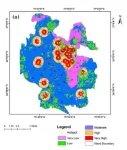One drop of blood brings progression of multiple myeloma into better view
Sensitive test opens door to personalized therapy
2021-03-26
(Press-News.org) A new method makes it much easier to follow the progression of multiple myeloma, a form of blood cancer. With a single drop of blood, it is possible to very accurately show whether the number of cancerous cells in the bone marrow is increasing in a patient. In time, this blood test could potentially replace the current bone marrow puncture.
Researchers at Radboud university medical center, in collaboration with Erasmus MC, have taken an important step towards implementing this new diagnostic, with a study published in Clinical Chemistry. Multiple myeloma is a severe form of blood cancer. Every year, in the Netherlands approximately 1,000 people are diagnosed with the disease. Improved treatments have made it possible to keep the disease under long-term control in an increasing number of patients. In some patients it even goes so well that no disease can be measured in the blood.
However, this does not mean that the malignant cells are all gone. Often these patient reach a state of minimal residual disease. Whether this is the case is currently measured by means of a bone marrow puncture. This is an unpleasant procedure for patients. Moreover, the test is not sensitive enough. Medical immunologist and last author Hans Jacobs: "The disease is found almost everywhere in the bone marrow, but in some areas you there are more cancerous cells than in other areas. So if you take a biopsy where there are fewer cancer cells, the test result does not accurately reflect the real situation. "
That's why there's clinical need for a good, reliable alternative. This is what Hans Jacobs, PhD student Pieter Langerhorst and colleagues at Erasmus MC found in a blood test using a mass spectrometry. This test can measure unique molecules, derived from cancer cells, in the blood. These molecules reveal the presence of the cancer cells in just a drop of blood. This allows you to see very quickly if the number of cancer cells in the body, or disease activity, is increasing. A treatment (for example, medication or chemotherapy) can then be started more quickly if necessary.
Multiple myeloma: errors in cell division
Multiple myeloma is an uncontrolled division of malignant white blood cells (plasma cells) in the bone marrow. Healthy plasma cells make antibodies, which protect us from infections and bacteria. In patients with multiple myeloma, something goes wrong with the cell division, causing a malignant proliferation of plasma cells in the bone marrow. These cancer cells make abnormal antibodies, also called M-proteins, which then end up in the blood.
Unique barcode for patients
Each M-protein contains a region that is unique to the cancer cells and the patient. This unique "barcode" distinguishes the healthy antibodies from those produced by the cancer cells. The research, made possible in part by KWF, showed that this barcode makes it possible to measure disease activity 1,000 times more sensitive than we are used to with current blood tests. In the current study, the scientists investigated whether the barcode in every patient is suitable for measuring with mass spectrometry.
Pieter Langerhorst: "We were able to use an international database of more than Multiple Myeloma 600 patients. In all patients we were able to find a suitable patient-specific barcode, making our new blood test applicable in every patient. This is beyond our expectations. With this study, we are taking an important step towards personalized diagnostics for patients with multiple myeloma. In the coming years, we want to do more research so that this method can hopefully be used in the clinic in due course."
INFORMATION:
Publication in Clinical Chemistry
Clonotypic Features of Rearranged Immunoglobulin Genes Yield Personalized Biomarkers for Minimal Residual Disease Monitoring in Multiple Myeloma - Pieter Langerhorst, Arie B Brinkman, Martijn M VanDuijn, Hans J C T Wessels, Patricia J T A Groenen, Irma Joosten, Alain J van Gool, Jolein Gloerich, Blanca Scheijen, Joannes F M Jacobs
(https://academic.oup.com/clinchem/advance-article-abstract/doi/10.1093/clinchem/hvab017/6168671)
ELSE PRESS RELEASES FROM THIS DATE:
2021-03-26
Perovskites, a class of materials first reported in the early 19th century, were "re-discovered" in 2009 as a possible candidate for power generation via their use in solar cells. Since then, they have taken the photovoltaic (PV) research community by storm, reaching new record efficiencies at an unprecedented pace. This improvement has been so rapid that by 2021, barely more than a decade of research later, they are already achieving performance similar to conventional silicon devices. What makes perovskites especially promising is the manner in which they can be created. Where silicon-based devices are heavy and require high temperatures for fabrication, perovskite devices can be lightweight and formed with minimal energy investiture. It is this combination - high performance ...
2021-03-26
New study led by the University of Helsinki supports the recognition of new species of South American owls, two of them, Xingu Screech Owl and Alagoas Screech Owl, described for the first time.
In early 2021 two new species of screech owls are being described in a single publication as new to science. A multinational team involving researchers from the University of Helsinki, Brazil, and the USA published a detailed study focusing on the morphological, vocal, and genetic variation in a group of screech owls from the Amazon and Atlantic Forest regions of South America, called the Black-capped / Tawny- bellied Screech Owl complex (Megascops atricapilla - M. watsonii). The term "complex" describes ...
2021-03-26
Every year, 10 million hectares of forest are lost. Among efforts to revive degraded or deforested land is the Bonn Challenge, with a global goal to bring into restoration 350 million hectares by 2030. Yet such efforts neglect the nuanced but critical factor of bringing genetic diversity into restoration efforts for long-term success, which urgently needs to be addressed.
Integrating genetic diversity involves planting tree species with different genetic makeups and varied species adapted to local environments. If species are the same, they will not be able to reproduce or grow new seedlings. Christopher Kettle, an ecologist and geneticist at the Alliance of Bioversity International and the ...
2021-03-26
As COVID-19 vaccines slowly roll out across the world, government officials in densely populated countries must still manage vulnerable communities at highest risk of an outbreak.
In a new study published in the Journal Risk Analysis, researchers in India propose a COVID Risk Assessment and Mapping (CRAM) framework that results in a zoned map that officials can use to place more targeted restrictions on high-risk communities. Successfully used by officials in Jaipur at the peak of the pandemic last spring, their framework could help other vulnerable countries avoid a shutdown of their regional economies.
Led by Shruti Kanga, associate professor in the Centre for Climate Change and Water Research at Suresh ...
2021-03-26
An estimated 6 million Americans may suffer from peanut allergies. Tiny amounts of peanut protein can lead to hives, itching, tingling in the mouth, shortness of breath or nausea within minutes.
For individuals with severe peanut allergies, food-induced anaphylaxis can occur. It's a life-threatening emergency that requires treatment with an injection of epinephrine and a trip to the emergency room. Food labels offer warnings such as "may contain peanuts" or "was processed in a facility that may process nuts."
The warnings allow individuals with severe reactions to steer clear, but for consumers who may be able to tolerate a minimal amount of peanut protein without major incident the labels aren't very useful, says Lynne Haber, PhD, ...
2021-03-26
Women who suffer from vision, hearing or dual sensory loss are more than twice as likely to report depression and anxiety as men who experience the same issues, according to a new study by Anglia Ruskin University (ARU).
The research, which has been published in the International Journal of Geriatric Psychiatry, looked at survey data from more than 23,000 adults, where participants had self-reported whether they had suffered depression or anxiety, and also whether they experienced vision, hearing, or dual (both vision and hearing) sensory impairment.
Across the whole sample, the prevalence of depression ...
2021-03-26
So far, there has been little research into supportive care needs in patients with newly diagnosed incurable cancer and as their disease progresses. That is why experts from the German Cancer Society's working group on palliative medicine, led by Professor Florian Lordick, Director of the University Cancer Center Leipzig (UCCL), surveyed 500 patients between the ages of 25 and 89. What made the project special was the fact that the patients were accompanied from the moment they were diagnosed and before receiving any treatment. Professor Lordick sums it up thus: "There is an urgent need for patients to have early access to supportive palliative ...
2021-03-26
Usually, the different areas in the cerebrum take on a very specific function. For example, they process our movements or things we see or hear, i.e. direct physical information. However, some areas of the brain come into play when dealing with more advanced mental tasks. They process incoming information that has already been pre-processed and is thus already at an abstract level.
It was already known that the inferior parietal lobe (IPL) is one of these regions in the human brain. Nevertheless, it was unclear how this area is able to process such very different functions. In a large study, scientists from the Max Planck Institute for Human Cognitive and Brain Sciences (MPI CBS) in Leipzig and McGill ...
2021-03-26
During a normal waking state, information is processed and shared by various parts within our brain to enable flexible responses to external stimuli. Researchers from the University of Turku, Finland, found that during hypnosis the brain shifted to a state where individual brain regions acted more independently of each other.
"In a normal waking state, different brain regions share information with each other, but during hypnosis this process is kind of fractured and the various brain regions are no longer similarly synchronised," describes researcher Henry Railo from the Department of Clinical Neurophysiology at the University of Turku.
The finding shows that the brain may function quite differently ...
2021-03-26
Scientists at the University of Bonn and the caesar research center have isolated a molecule that might open new avenues in the fight against SARS coronavirus 2. The active ingredient binds to the spike protein that the virus uses to dock to the cells it infects. This prevents them from entering the respective cell, at least in the case of model viruses. It appears to do this by using a different mechanism than previously known inhibitors. The researchers therefore suspect that it may also help against viral mutations. The study will be published ...
LAST 30 PRESS RELEASES:
[Press-News.org] One drop of blood brings progression of multiple myeloma into better view
Sensitive test opens door to personalized therapy






